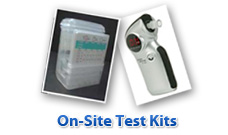Welcome!
Drug Misuse – the Hazard of Dirty Needles
A public hazard facing many councils across the UK is the discarding of dirty needles, syringes and other drug-related litter (DRL) in public places such as public toilets, car parks, bus stations, residential streets, playparks, footpaths and churchyards and beaches. In an alleyway behind one street dubbed ‘Crack Alley’ in Derbyshire (UK), over the course of one weekend in 2006 an alleged 1100 needles were recovered during a clean-up operation. On an average weekend, between 200 and 300 used needles were reportedly routinely cleared up from this location.
Risks from Needles
Such syringes are commonly referred to as “sharps” which is the collective name for hyperdermic needles, syringes, razors and other objects that have the potential to puncture someone and infect them. Blood borne diseases which may be passed include HIV, hepatitis B and hepatitis C.
The fear the general public has regarding discarded needles may be compounded by a lack of basic knowledge about illegal drugs and further reinforced by urban myths or hoax emails citing untrue and far-fetched stories of an unfortunate person sitting on an infected needle purposefully placed point upwards on a cinema seat, or being punctured by an infected needle left in the returned change slot of a pay phone. The fear of what many people know very little about can be partly dispelled with a basic knowledge – in this case about drugs, drug users and their habits, and what to do in the case of finding a needle or being injured by one.
What should you do if you find a dirty needle?
What should you do if you find a dirty needle? In general, advice is NOT TO TOUCH a discarded needle or syringe and if you are a child, report your find to an adult such as your teacher, a police officer or your parents as soon as possible. If sharps are found on council owned property, they have a duty to have them removed and will often have a sharps removal kit which includes a proper sharps disposal bin and staff will be trained to handle this type of waste removal safely.
If there is an immediate danger such as children playing and the syringe must be removed at once, do not hide it, kick it down a drain, flush it down a toilet, throw it in a dustbin or into a fireplace. Never touch the sharp with your bare hands. If possible, put on some heavy duty gloves and pick up the item using tongs at arms length (never scissors), or sweep up with a dustpan and brush, sweeping away from the body.
Syringes should be picked up by the middle of the barrel and tipped needle end first into a plastic or metal container, preferably with a lid. If necessary, use a hard plastic bottle or a drinks can. Wash hands thoroughly afterwards.
Needlestick Injuries
Whilst we aren’t able to give medical advice, the common information on the internet states: If a puncture wound has occurred, try not to panic. Encourage bleeding by squeezing gently for a couple of minutes, do not suck the wound, wash thoroughly with soap and water for five minutes and attend the accident and emergency ward at your nearest hospital as soon as possible so that further advice and immunisation can be offered.
Needle Exchange
Needle and Syringe Exchange programmes are a positive step towards reducing discarded used needles and helping injecting drug users to handle their addiction responsibly and without causing danger to other members of the public. Needle Exchanges aim to provide new and unused needles to injecting drug users to prevent them from sharing dirty ones and also to offer proper disposal bins for used needles. This service is provided in a number of easily accessible places including high street chemists such as Boots and even selected pharmacies within large supermarkets like Sainsburys.
If you have any questions about addiction, visit our Tackling Drug Addiction for Friends and Families page or our home drug test FAQ page. Alternatively, visit our workplace drug testing page for more information for employers. We offer drug awareness training and drugs and alcohol policy development services.
Tags: Drug Information, Drug Misuse, Hazards of Dirty Needles, Illegal Drugs, Needle Exchange, Needlestick Injury






